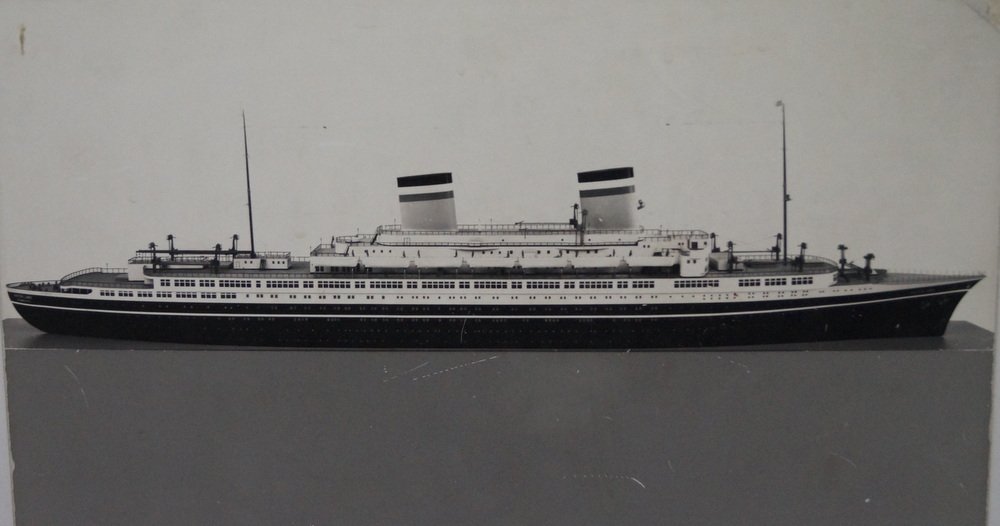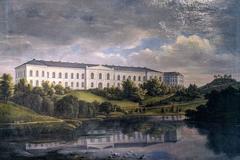
Museum Für Hamburgische Geschichte: Visiting Hours, Tickets, and Comprehensive Guide to Hamburg Historical Sites
Date: 14/06/2025
Introduction
The Museum Für Hamburgische Geschichte (Museum of Hamburg History) is a cornerstone of the city’s vibrant cultural landscape. Nestled in central Hamburg, it offers an immersive journey through more than 1,200 years of urban heritage, from the medieval fort of Hammaburg to Hamburg’s emergence as a major international city. Renowned not only for its extensive collections and interactive exhibits but also for its architectural significance as a Fritz Schumacher masterpiece, the museum is a vital resource for understanding Hamburg’s urban identity, maritime legacy, and diverse communities.
Currently, the museum is undergoing a major modernization and is temporarily closed until 2027. However, through digital initiatives, virtual tours, and city walks, the institution continues to foster cultural dialogue and educate the public. This detailed guide offers essential information on the museum’s history, architectural features, modernization project, visitor information, accessibility, and nearby historical attractions. For further details, consult the official Museum Für Hamburgische Geschichte website and digital resources like Google Arts & Culture.
Table of Contents
- Introduction
- Historical Development and Architectural Significance
- Visitor Information
- Multimedia and Interactive Features
- Museum’s Cultural Role and Educational Outreach
- Modernization Project Overview
- Nearby Attractions and Hamburg Historical Sites
- Practical Visitor Tips
- Frequently Asked Questions (FAQ)
- Summary and Recommendations
- References
Historical Development and Architectural Significance
Origins and Early Collections
The museum’s roots trace back to the Society of Hamburg History (Verein für Hamburgische Geschichte), founded in 1839, and the Sammlung Hamburger Altertümer, a collection of architectural fragments from historic city buildings like St. Mary’s Cathedral (Wikipedia). The museum officially opened in 1908, initially occupying the Johanneum school, before moving to its purpose-built home.
Establishment at Holstenwall
The current building at Holstenwall 24, designed by Fritz Schumacher, began construction in 1914 and opened in 1922 after delays caused by World War I (Google Arts & Culture). The site, formerly the Hamburg Observatory and part of the Bastion Henricus fortification, is historically significant (Wikipedia). The museum transitioned to public ownership under Otto Lauffer and rebranded as “hamburgmuseum” in 2006, expanding its outreach and programming.
Architectural Highlights
Schumacher’s design features a brick façade, expansive atrium, and grand staircase, blending monumentality with inviting spaces (Google Arts & Culture). The building’s layout connects physically and symbolically to Hamburg’s urban development, with relics like the 1604 Petri portal anchoring it in local heritage (Wikipedia). Modern additions include a glass dome (added in 1989 by Von Gerkan, Marg and Partners), which brings natural light and additional exhibition space (Wikipedia).
Visitor Information
Visiting Hours
Current Status: The museum is closed for renovations until an anticipated reopening in 2027. Normally, standard hours are Tuesday–Sunday, 10:00 AM–6:00 PM. For updates, visit the official museum website.
Tickets and Admission
Before closure, admission was €5, with discounts for students, groups, and Hamburg Card holders; children and youth under 18 entered free. Updated prices and ticketing information will be published closer to the reopening date (Hamburg.de Eintrittspreise).
Accessibility
The museum is committed to full accessibility with ramps, elevators, accessible restrooms, and tactile exhibits for visitors with disabilities. Services include audio guides, guided tours in German Sign Language, and participatory programs (Hamburg.de Barrierefreiheit).
Getting There
- Location: Holstenwall 24, 20355 Hamburg.
- Public Transport: U-Bahn Line U3 (St. Pauli stop, ~5-minute walk); Bus 112 (Museum für Hamburgische Geschichte stop); additional connections via Messehallen (U2) and bus lines 3, 35, 36 (Hafenrundfahrt.com).
- Parking: Limited; several public garages are within walking distance.
Multimedia and Interactive Features
The museum offers a robust digital presence:
- Virtual Tours: Explore the collection and exhibits online via Google Arts & Culture.
- AR App: The “Auf der Spur der verschwundenen Stadt” app reconstructs lost buildings and urban landscapes using augmented reality (Hamburg Travel).
- Online Events: Digital lectures, workshops, and guided city walks engage visitors during the closure (Hamburg.de Veranstaltungen).
Recommended: Enhance the digital experience with images of the museum’s exterior, scale models, and interactive installations, each with descriptive alt text.
Museum’s Cultural Role and Educational Outreach
Preserving Urban Identity
The museum chronicles Hamburg’s transformation from the Hammaburg fort (~800 CE) to a Hanseatic trade hub and modern metropolis. Highlights include medieval city models, maritime artifacts, and engaging displays on the city’s Jewish community and pivotal events like the Great Fire of 1842 (WhichMuseum).
Inclusive Narratives and Social Engagement
Initiatives like “Mein Hamburg!” and collaborations with organizations such as Körber-Stiftung and Patriotische Gesellschaft von 1765 highlight diverse voices and social movements (Museum für Hamburgische Geschichte). The museum addresses topics ranging from migration to religious transformation, fostering critical dialogue.
Educational Innovation
Interactive and mobile exhibits, tactile models, and digital storytelling projects reach audiences beyond the museum, including schools and community groups (Museum für Hamburgische Geschichte).
Modernization Project Overview
Vision and Implementation
A major renovation underway since 2023 aims to create a more accessible, sustainable, and digitally innovative museum. The €36 million project is jointly funded by federal and city governments, with key partners including Sprinkenhof GmbH, Hoskins Architects, and jangled nerves (SHMH Modernisation).
Architectural and Exhibition Enhancements
- Structural Upgrades: Improved energy efficiency, barrier-free access, new elevators, and integration with Planten un Blomen park (Hamburg.de Modernisierung).
- Exhibition Redesign: A new chronological-thematic tour, thematic “islands” focusing on iconic Hamburg sites, and cross-cutting themes such as migration and urban change (SHMH Redesign).
- Digital Innovation: Expanded AR experiences, multimedia installations, and participatory exhibition design (Hamburg Travel).
Nearby Attractions and Hamburg Historical Sites
Enhance your visit to Hamburg by exploring nearby landmarks:
- Planten un Blomen Park: Adjacent green oasis with gardens and seasonal events.
- Speicherstadt Warehouse District: UNESCO World Heritage Site, showcasing Hamburg’s trading history.
- Hamburg Rathaus (City Hall): Neo-Renaissance marvel a short distance away.
- St. Michael’s Church & Elbphilharmonie: Iconic city landmarks.
- Dom (Hamburg Fair): Major cultural event held multiple times yearly.
For more, see Hamburg Travel.
Practical Visitor Tips
- Stay Updated: Regularly check the official website for reopening news and event announcements.
- Explore Digitally: Use the AR app and virtual tours during the closure.
- Plan Ahead: Contact visitor services for accessibility or group tour arrangements post-renovation.
- Combine Visits: Extend your Hamburg experience with nearby historical sites and cultural attractions.
Frequently Asked Questions (FAQ)
Q: When will the museum reopen?
A: Reopening is anticipated in 2027 after major renovations.
Q: How do I buy tickets?
A: Ticketing details will be updated prior to reopening; previously, admission was €5 (with discounts and free entry for under-18s).
Q: Is the museum accessible?
A: Yes, the modernization ensures full barrier-free access, including ramps, elevators, and accessible restrooms.
Q: What digital features are available during closure?
A: Virtual tours, online events, and the AR app allow visitors to explore Hamburg’s history remotely.
Q: What other sites should I visit nearby?
A: Speicherstadt, Planten un Blomen, Hamburg Rathaus, St. Michael’s Church, and the Elbphilharmonie are all recommended.
Summary and Recommendations
The Museum Für Hamburgische Geschichte is a vital institution safeguarding Hamburg’s multifaceted past and cultural identity. Its collections, innovative exhibitions, and architectural elegance make it an essential stop for understanding the city’s evolution. While closed for modernization until 2027, visitors can stay engaged through digital offerings and city events. Anticipate a revitalized experience with improved accessibility, participatory exhibits, and cutting-edge technology upon reopening.
For current updates, digital resources, and event schedules, visit the official museum website, download the AR app “Auf der Spur der verschwundenen Stadt,” and follow museum social channels. Whether in person or virtually, the Museum Für Hamburgische Geschichte offers a gateway to the heart of Hamburg’s urban story (Hamburg Travel).
References and Further Reading
- Wikipedia
- Google Arts & Culture
- WhichMuseum
- Official Museum Website (SHMH)
- SHMH Modernisation
- Hamburg Travel
- Hamburg.de Accessibility & Modernization
- Hafenrundfahrt.com





















































































